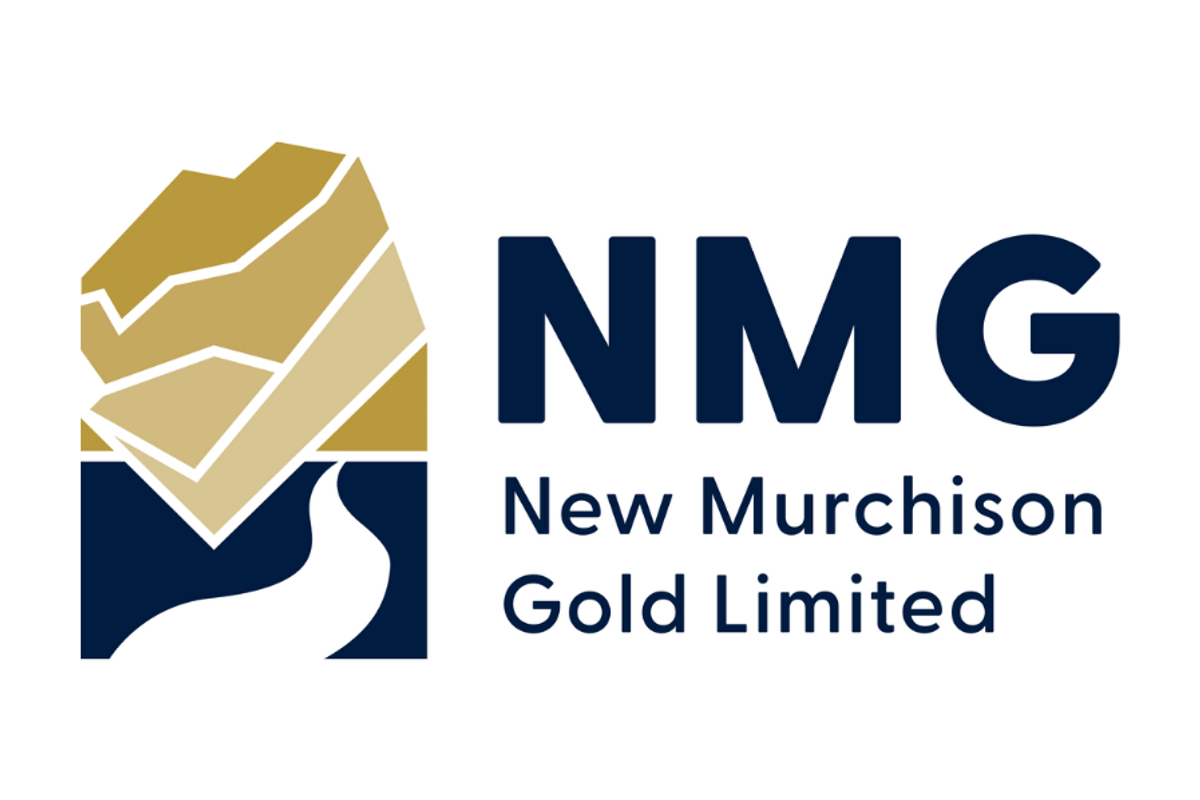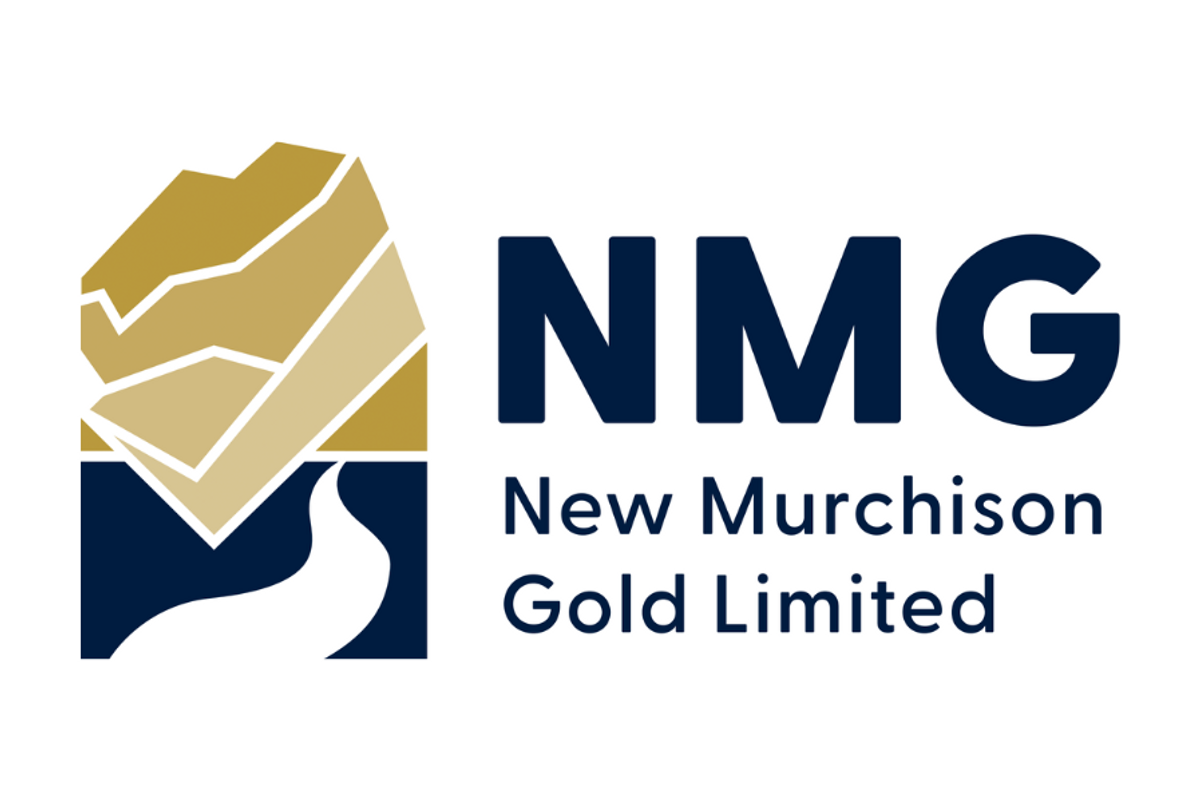
November 27, 2024
New Murchison Gold Limited (ASX: NMG) (“NMG” or the “Company”) is pleased to announce an updated Mineral Resource Estimate (MRE), reported in accordance with the JORC Code, for the Crown Prince Deposit (Crown Prince) at the Company’s flagship Garden Gully Gold Project (Garden Gully) near Meekatharra, Western Australia.
HIGHLIGHTS
- Mineral Resource Estimate substantially increased for the Crown Prince Deposit at Garden Gully with a 3G% increase in the Indicated classification estimate to 226koz at 4.6 g/t Au.
- The total Mineral Resource has grown by 16% from the February 2024 estimate, to 27Gkoz at 3.G g/t/Au.
- With 81% (up from 68%) of gold ounces in the Indicated Mineral Resource classification, there is now a strong understanding of the Crown Prince deposits, reflecting enhanced drill density, in some places to 15 m x 15 m grid.
- Mineral Resources are shallow and delineated from surface. Gold mineralisation is open at depth and will be followed up with deeper drilling as the project progresses.
- Crown Prince’s mineralisation is mostly situated within a 300 m x 380 m area. The Mineral Resource Estimate, beneath the mineralised cap rock, shows an average of 1,538 oz of gold per vertical metre between 10 m and 150 m depth.
- The structural corridor, which hosts the Crown Prince deposits, is open to the south and is relatively untested. To the north, recent passive seismic delineated a wide and thick paleochannel (up to 60 m depth). The northern area below the paleochannel may be better explored from underground or base of open pit positions.
- Crown Prince is strategically located in the heart of the prolific Murchison gold district, with close proximity to numerous operating gold mines, processing facilities and other key infrastructure.
- NMG is close to announcing a detailed Feasibility Study (environmental, social, mining, metallurgy, geotechnical, hydrogeological) to support a robust value proposition for mining Crown Prince
Alex Passmore, NMG’s CEO commented: “Following a busy year of exploration and development work in 2024, the Company is delighted to report an increased Crown Prince Mineral Resource Estimate from the additional drilling undertaken.
With increased drilling density, the understanding of the Crown Prince deposit is at a strong confidence level with 81% of the ounces (i.e., 22C,000 oz) now reporting to the Indicated Mineral Resource classification. Pleasingly, the average ounce per vertical metre endowment sits at 1,538 within key areas of our conceptual open pit development.
This resource underpins the detailed feasibility study work which is well advanced to confirm the mining, metallurgical, geotechnical, economic and environmental parameters to develop the Crown Prince Gold Project.
Initial economic optimisation modelling of the Crown Prince resource confirms that there is sufficient grade and tonnage to sustain an open pit mining operation.”
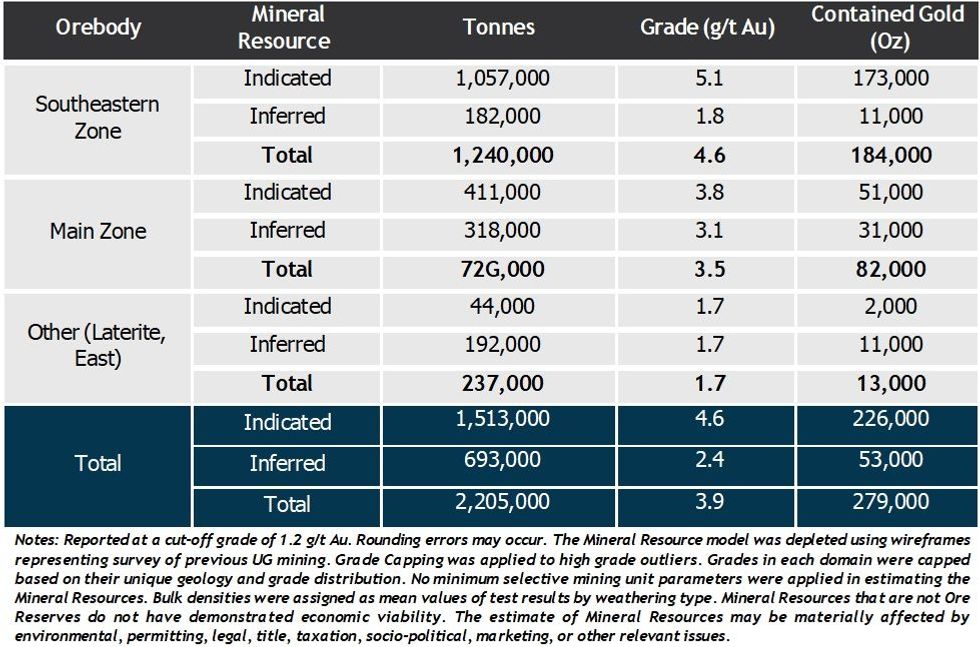
This MRE (Table 1, Figure 1) was prepared by Cube Consulting, an independent consultant, using geological and mineralisation interpretations prepared by NMG using all available reverse circulation and diamond drillhole data. The updated Crown Prince MRE incorporates all drilling completed and assayed up to October 2024. Over the course of 2024, NMG’s exploration team completed 21,974 m of reverse circulation and diamond drilling within the Crown Prince area.
Following the discovery of the south eastern zone (SEZ) of mineralisation at Crown Prince in 2022, follow up exploration in 2023 and 2024 successfully added resource inventory via infill and extensional drilling.
Multiple phases of drilling were undertaken in 2024 (Table 2) with resulting assays now incorporated into the resource model supporting the November 2024 estimate for Crown Prince.
Mineralisation envelopes at the Main and Northern Zones were also better defined for this model. Additionally, new high-grade lodes were discovered in the Northern Zone contributing to the uplift seen in this updated MRE.
The Crown Prince deposit is hosted within quartz-carbonate veins within altered and sheared mafic units. In the weathered profile, primary mineralisation (fresh rock) has in places been enriched with a supergene overprint. Notably, primary mineralisation persists at depth and remains open (Figure 2). Further drilling will be undertaken to test for extensions.
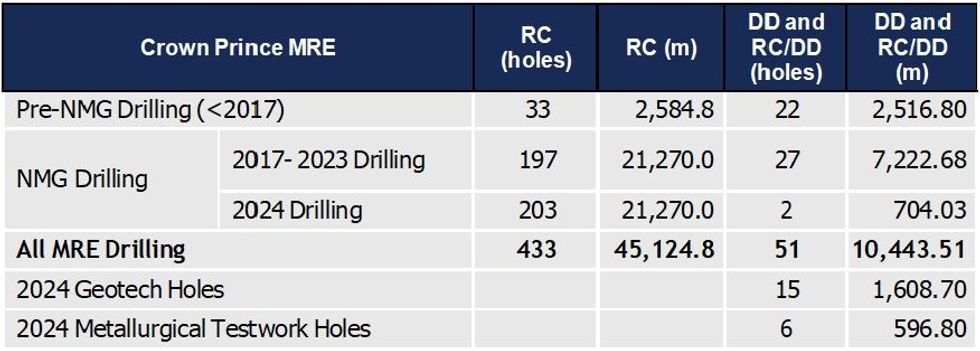
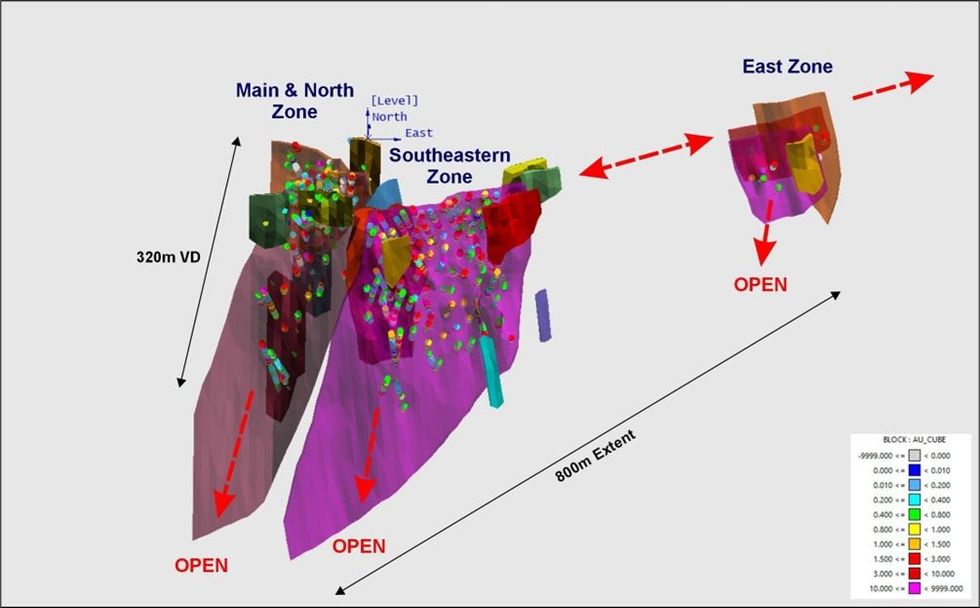
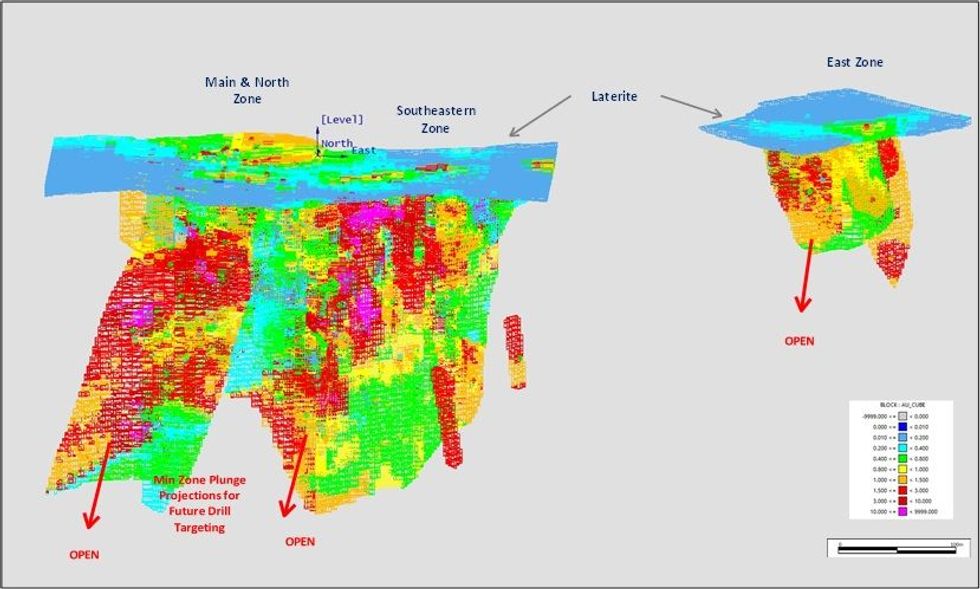
Material Information Summary – Mineral Resources
Information required by ASX Listing Rule 5.8.1 (summary of technical information pertaining to the Mineral Resource Estimate) is detailed in the following sections.
Click here for the full ASX Release
This article includes content from New Murchison Gold Limited, licensed for the purpose of publishing on Investing News Australia. This article does not constitute financial product advice. It is your responsibility to perform proper due diligence before acting upon any information provided here. Please refer to our full disclaimer here.
NMG:AU
The Conversation (0)
02 April
New Murchison Gold Limited
Advanced gold exploration company with a path to production
Advanced gold exploration company with a path to production Keep Reading...
20 June
Trading Halt
New Murchison Gold Limited (NMG:AU) has announced Trading HaltDownload the PDF here. Keep Reading...
12 June
Further High-Grade Gold Intersections at Crown Prince
New Murchison Gold Limited (NMG:AU) has announced Further High-Grade Gold Intersections at Crown PrinceDownload the PDF here. Keep Reading...
27 May
Grade Control Drilling Results
New Murchison Gold Limited (NMG:AU) has announced Grade Control Drilling ResultsDownload the PDF here. Keep Reading...
12 May
High-Grade Gold Intercepts within Caprock Drilling
New Murchison Gold Limited (NMG:AU) has announced High-Grade Gold Intercepts within Caprock DrillingDownload the PDF here. Keep Reading...
30 April
Second Quarter Activities and Cashflow Report
New Murchison Gold Limited (NMG:AU) has announced Second Quarter Activities and Cashflow ReportDownload the PDF here. Keep Reading...
19 December
Armory Mining Announces Closing of Flow-Through Financing
(TheNewswire) THIS NEWS RELEASE IS NOT FOR DISTRIBUTION TO U.S. NEWSWIRE SERVICES OR FOR DISSEMINATION IN THE UNITED STATES Vancouver, B.C. December 19, 2025 TheNewswire - Armory Mining Corp. (CSE: ARMY) (OTC: RMRYF) (FRA: 2JS) (the "Company" or "Armory") a resource exploration company focused... Keep Reading...
18 December
More high grade gold intercepts at BMT3 in Boundiali
Aurum Resources (AUE:AU) has announced More high grade gold intercepts at BMT3 in BoundialiDownload the PDF here. Keep Reading...
18 December
Top 5 Australian Mining Stocks This Week: Taruga Minerals Climbs on Acquisition of Gold-Copper Projects
Welcome to the Investing News Network's weekly round-up of the top-performing mining stocks listed on the ASX, starting with news in Australia's resource sector.Many of this week's top stocks jumped on news of project acquisitions. Gold companies remained in the spotlight this week as precious... Keep Reading...
18 December
John Feneck: Gold, Silver in 2026, Plus 9 Stocks I'm Bullish on Now
John Feneck, portfolio manager and consultant at Feneck Consulting, shares his thoughts on silver's price breakout, as well as potential triggers for gold's next move up. He also discusses stocks he's watching in sectors like gold, silver and "special situations."Don't forget to follow us... Keep Reading...
18 December
iMetal Resources Completes Flow-Through Financing
iMetal Resources Inc. (TSXV: IMR,OTC:IMRFF) (OTCQB: IMRFF) (FSE: A7VA) ("iMetal" or the "Company) announces that has closed its non-brokered private placement (the "Offering") of flow-through units (each, an "FT Unit"). In connection with closing, the Company has issued 4,160,777 FT Units, at a... Keep Reading...
17 December
Inside West Africa’s Expanding Gold Exploration and Investment Landscape
Faced with declining reserves in mature mining jurisdictions, gold producers and explorers are shifting their attention toward regions offering scale, geological upside and room for new discoveries. West Africa is increasingly filling that role. Stretching from Senegal to Ghana, the region has... Keep Reading...
Latest News
Interactive Chart
Latest Press Releases
Nevada Sunrise Announces Stock Option Grants
19 December
Related News
TOP STOCKS
American Battery4.030.24
Aion Therapeutic0.10-0.01
Cybin Corp2.140.00


